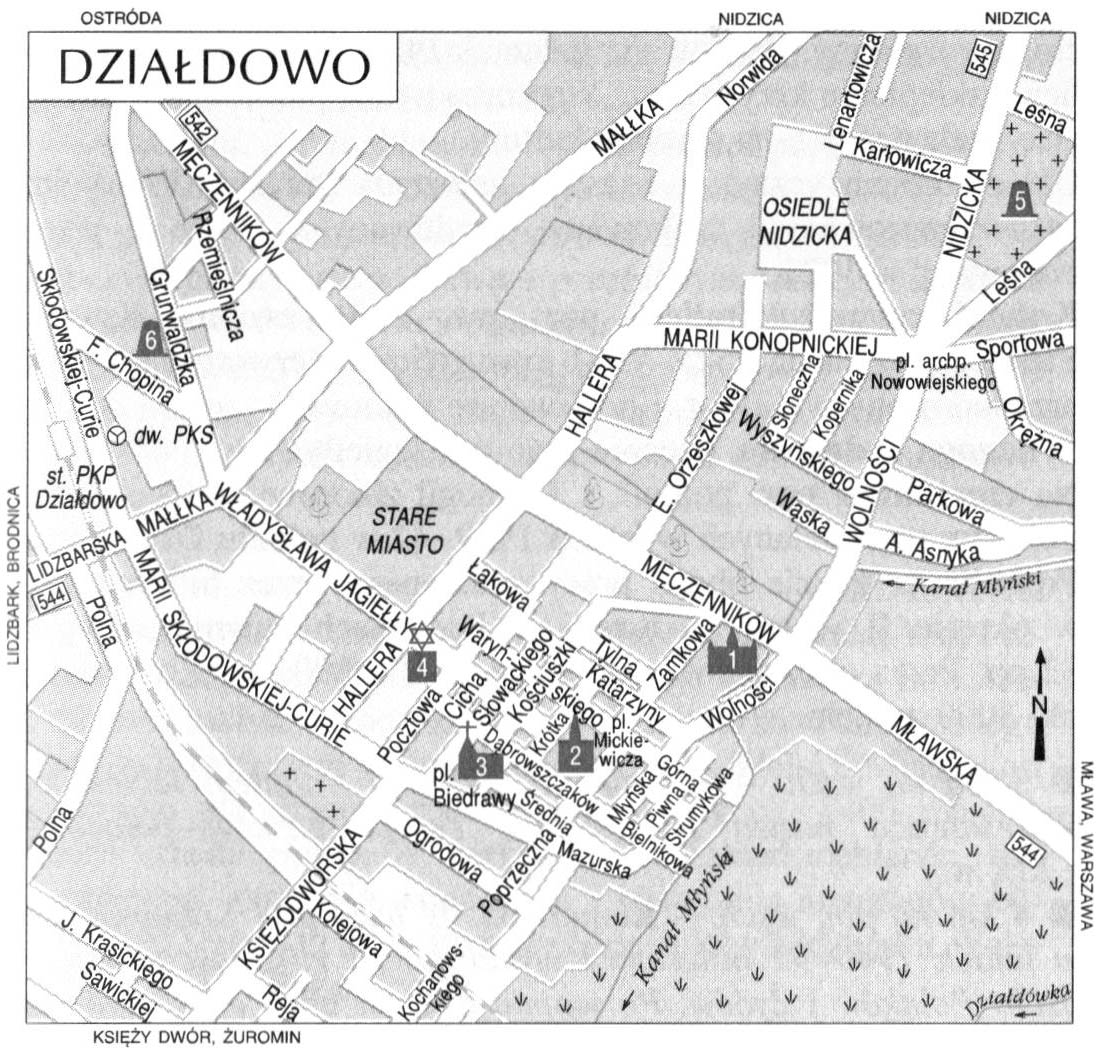 DEPARTMENT – 1. Teutonic castle 2. Town hall 3. Church of the Exaltation of the Holy Cross 4. Synagogue 5. Monument and graves of executed Poles 6. Monument in the labor camp established by the Nazis
DEPARTMENT – 1. Teutonic castle 2. Town hall 3. Church of the Exaltation of the Holy Cross 4. Synagogue 5. Monument and graves of executed Poles 6. Monument in the labor camp established by the Nazis
The city to the south. the end of Garb Lubawski, on the Działdówka river (the name of the headwaters of Wkra). Ok. 21 000 inhabitant. The seat of the commune and commune offices. From 1999 r. county town. Industrial center (glassworks specializing in the production of bottles, food factories, furniture maker, printing house). Railway and road junction. The Association of the Enthusiasts of the Działdowo Region is active here.
In the early Middle Ages there was a stronghold of the Sasin Prussian tribe. In his place in 1306 r. a Teutonic castle was built, and in the vicinity a settlement
named Soldau (Soldow). The administrator of the area was the head of the Teutonic Order, called the prosecutor. City rights were granted in 1344 r. by the Teutonic master Ludolf Konig. At the end of the 14th century. The name Działdowo appeared. In years 1376 i 1409 the city was captured and burnt by Lithuanians. 13 July 1410 r. the Teutonic castle was occupied by the Polish-Lithuanian-Ruthenian army led by King Władysław Jagiełło during his expedition against the Teutonic Knights. W 1414 r. the castle was again captured by the Polish army. Later, Działdowo was given to the Duke of Mazovia, Siemowit. W 1460 r. the city was occupied by the Teutonic Knights. After the peace of Toruń was established in 1466 r. the city again passed into the hands of the Teutonic Knights. W 1656 r. The Swedish king, Charles X Gustaw, quartered in Działdowo. Then the city was destroyed and plundered by the Tatars from a unit of subchan Ghazi-agi supporting the Lithuanian army commanded by field hetman Wincenty Aleksander Gosiewski. In the 16th-17th centuries. development of trade and crafts. During the partitions, it was a strong center of maintaining patriotic attitudes. W 1920 r. under the Treaty of Versailles, the city was returned to Poland. During the Polish-Bolshevik war in August 1920 r. a group of Polish troops under the command of gen. Habichta. 18 of August 1920 r. an enemy entered the city 12 a division that was part of the 4th army. In the interwar period, a thriving center of culture in Masuria. The Society of the Friends of Masuria was active, Masurian People's House, "Gazeta Mazurska" was published (1922—23). W 1927 the Masurian Museum was opened. During 11 During World War II, the Nazis incorporated the city into East Prussia and established a prisoner-of-war camp here, and then a transit camp for the displaced Polish population, soon transformed into an extermination camp. Murdered here. 3000 people, mainly representatives of the intelligentsia, the bodies were secretly buried in the surrounding forests.
A Teutonic castle built of brick on a square plan, formerly also a three-story residential building and two towers. Destroyed many times, w XVI i XVII w. partially demolished. One wing with a Renaissance chapel with a cross vault is preserved. Protection and adaptation works for the cultural center are underway in the castle.
The urban layout from the time when the town was founded. In the market square, a brick and plastered town hall, built in 1796 r., rebuilt in 1922 r.
Roman Catholic Church, parish. pw. Exaltation of the Holy Cross, in years 1525-1981 Protestant, originally gothic, rebuilt in 1794 r. and after World War II.
Jewish synagogue, currently a cinema (ul. Jagiełło).
At the cemetery of parish. monument i 11 collective graves approx. 15 000 Poles shot in the years 1939-42 near Działdowo. Monument at the labor camp established by the Nazis during World War II in the buildings of the former barracks 32 pp. More than passed through the camp 20000 people, of which approx. 3000 was lost.
3 km to the east. – Malinowo. A village on the Młyński Canal. Formerly known as Amałienhof. 19th-century park and palace complex.
4 km to the north. east. – Bailiffs. In the forest near Komorniki in the years 1940-42 the Nazis murdered several thousand people: Poles and Jews. After the war, the remains of the victims were exhumed and moved to mass graves to the cemetery of war victims in Komorniki.. In the cemetery there is an impressive monument in the shape of an open hand.
3 km to the south. zach. – Księży Dwór. Village. Formerly known as Niederhof. Large palace and park complex, which they are composed of: palace, court, pheasant house, grain warehouse, barn, fold, two barns, smithy, distillery and fours.
At distance 1 km to the south. zach. from the village an early-medieval conical stronghold of a height 10 m.
